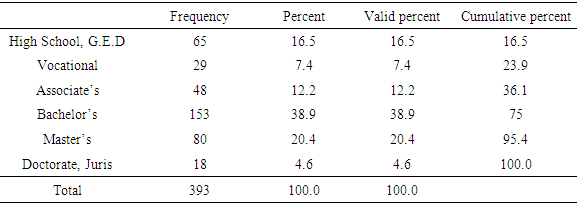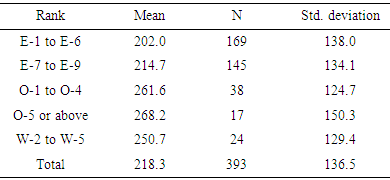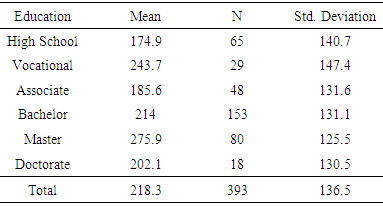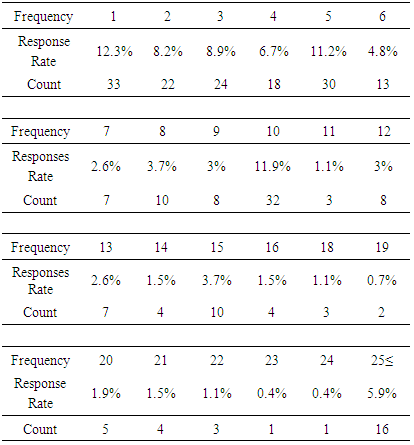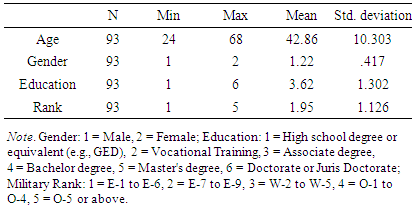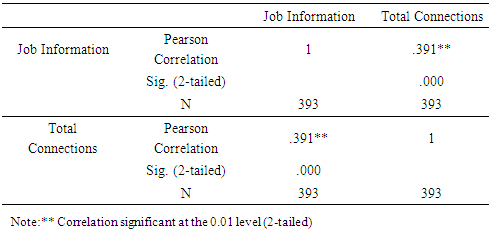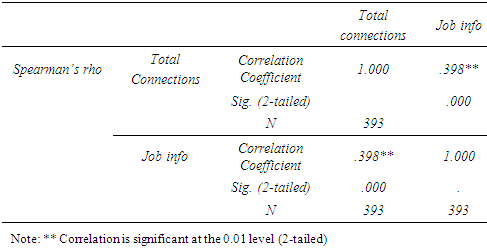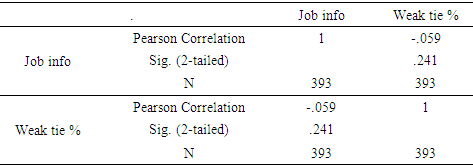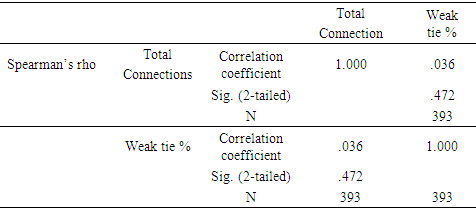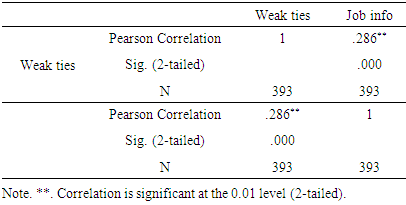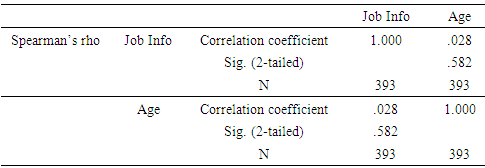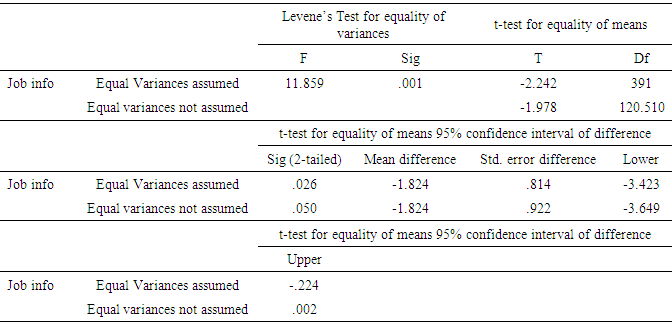-
Paper Information
- Paper Submission
-
Journal Information
- About This Journal
- Editorial Board
- Current Issue
- Archive
- Author Guidelines
- Contact Us
Human Resource Management Research
p-ISSN: 2169-9607 e-ISSN: 2169-9666
2015; 5(6): 133-153
doi:10.5923/j.hrmr.20150506.01

Social Media Job Searches and the Strength of Veteran Ties
Chad Michaels Weinburger1, Sheila Hadley Strider2, Edward Felix Vengrouskie3
1Department of Business, Columbia Southern University, Orange Beach, United States
2Deparment of Business and Mass Communication, Brenau University, Gainsville, United States
3Department of Management, Ft Hays State University, Hays, United States
Correspondence to: Edward Felix Vengrouskie, Department of Management, Ft Hays State University, Hays, United States.
| Email: |  |
Copyright © 2015 Scientific & Academic Publishing. All Rights Reserved.
This work is licensed under the Creative Commons Attribution International License (CC BY).
http://creativecommons.org/licenses/by/4.0/

The United States military veteran population historically ranks higher in unemployment rates than their civilian counterparts have in similar demographic categories. The use of professional social networking sites (SNS), such as LinkedIn.com, offer a new medium for job information diffusion among veterans actively or passively seeking new employment. Very little literature existed concerning veteran utilization of SNS to gain job information, or if any relationship existed to their egocentric network alters. In this study, quantitative correlation research indicated the statistical correlation between LinkedIn connection quantity and tie strength to determine the relationship that existed with having acquired information about possible employment opportunities via LinkedIn.com. The sample population consisted of U.S. Navy Veterans and Active Duty Sailors within 12 months of separation or retirement from active duty. We analyzed 393 U.S. Navy Veterans’ or transitioning Sailors’ responses to an online survey yielded a weak to moderate positive relationship between the absolute number of LinkedIn connections and absolute number of LinkedIn weak connections. We also examined independent variables of age, gender, education level, and military rank to determine if these were contributing factors to having received job information via LinkedIn.
Keywords: LinkedIn, Social Networking Sites, Military Veteran Employment, Strength of Weak Ties Theory, Talent Acquisition
Cite this paper: Chad Michaels Weinburger, Sheila Hadley Strider, Edward Felix Vengrouskie, Social Media Job Searches and the Strength of Veteran Ties, Human Resource Management Research, Vol. 5 No. 6, 2015, pp. 133-153. doi: 10.5923/j.hrmr.20150506.01.
Article Outline
1. Introduction
- The United States military veteran population historically ranks higher in unemployment rates than their civilian counterparts have in similar demographic categories. The use of professional social networking sites (SNS), such as LinkedIn.com, offer a new medium for job information diffusion among veterans actively or passively seeking new employment. Very little literature existed concerning veteran utilization of SNS to gain job information, or if any relationship existed to their egocentric network alters. This quantitative correlation research indicated the statistical correlation between LinkedIn connection quantity and tie strength to determine the relationship that existed with having acquired information about possible employment opportunities via LinkedIn.com. The sample population consisted of U.S. Navy Veterans and Active Duty Sailors within 12 months of separation or retirement from active duty. The analysis of 393 U.S. Navy Veterans’ or transitioning Sailors’ responses to an online survey yielded a weak to moderate positive relationship between the absolute number of LinkedIn connections and absolute number of LinkedIn weak connections. We examined independent variables of age, gender, education level, and military rank to determine if these were contributing factors to having received job information via LinkedIn.
2. Professional Social Networking
- LinkedIn belongs to a group of professional SNS (Boyd & Ellison, 2007). Founded in 2003, its membership was counted at 225 million users as of 2013 (LinkedIn About Us, 2015). LinkedIn’s growth and expansion as a professional social network provided a rich online environment to research social networks. In order to accomplish this, it was necessary to understand the field of Social Networking Analysis (SNA) applied to job searches for U.S. Naval Veterans. Two primary domains emerged from examination of existing literature. The first domain related to social network theory and its derivative theories. The second more modest domain related to the target population and the challenges associated with veteran job searches.Apart from initial hiring, social network usage could be an influential factor for the initial salary and the promotion of longer employment duration with the organization due to referral from network connections. For example, Dustmann, Glitz, and Schönberg (2011) suggested that referrals sometimes lead to higher initial salaries. Although, Goel and Lang (2009) found that the higher salary was not due to the referral, but led to more employment options. The referrals and recommender systems are part of the “instrumental Internet,” which could serve as a medium for information seeking, knowledge gathering, and commercial transactions (Tufekci, 2008). New technologies such as social networking sites act as bridges from traditional SNA foundations to the current research. One contribution to the field was the Pew Research Center’s Internet and American Life Project paper that studied how SNS affects users’ lives (Hampton, Goulet, Rainie, & Purcell, 2011). In addition, Hampton et al. questioned adult internet use, SNS use, and their growth. By studying variables such as gender, age, education, internet usage, and SNS membership, researchers provided a comprehensive profile of today’s SNS user. Hampton et al. explored SNS sites such as MySpace, Facebook, LinkedIn, Twitter, and “other SNS.” New technology, such as internet and mobile phones, have caused modified interactions between social network ties. This statement is supported by an examination of 20 years of responses to the US General Social Surveys (GSS) that indicated personal social networks’ size had decreased and become less diverse (Hampton, Sessions, & Her, 2010; Marsden, 2013). Hampton et al. (2010), and Marsden (2013) utilized GSS to collect demographic information for inclusion as variables in scientific research. Smith, Hout, and Marsden (2013) noted that International Social Survey Program researchers conducted cross-national collaboration studies on global social trends have utilized GSS results. Presently, the preferred method to receive referrals is through job information links passed through SNS ties or endorsements (Tang, Hu, & Liu, 2013). Oechslein and Hess (2014) examined the strength of tie and job information acquisition and recommendations in the SNS environment. Oechslein and Hess tested Facebook connection and found that a strong tie relationship positively correlated to the value of a recommendation. Oechslein and Hess concluded that credibility of the recommending person and the recommendation's media source affects the value of a recommendation. However, not all recommendations and networks are equal in social capital return. McDonald (2011) analyzed referrals and recommendations relating to labor market inequalities. The basis of the research was to test the “Old Boy” network that consisted of high-status white males. The hypothetical premise was that the white male population maintained higher levels of social capital than women and minority populations and thus was likely to receive more job information. McDonald utilized the definition from Lin et al. (2001) of social capital as including resources such as information, influence, and status. McDonald utilized the Social Capital USA survey to sample 2,735 respondents and found a correlation between gender and race with access to social capital resources. Other researchers saw similar results and their work served as evidence that social networks mirror labor market inequalities (Hamm & McDonald, 2015; Smith, 2003, 2007). Hamm and McDonald (2015) and Smith (2003) found evidence that a social network with high social capital was beneficial.Regardless of network quality, in order for individuals to benefit from their social networks, alters must be willing to provide job information. Wiese, Min, Hong, and Zimmerman (2015) examined Facebook’s mobile application users. Wiese et al. inferred that tie strength was a predictor for a willingness to share with connections. Wiese et al. deduced that this willingness demonstrated a propensity to share within groups such as those available on Facebook and LinkedIn. Bakshy, Rosenn, Marlow, and Adamic (2012) found contradictory results regarding information diffusion among Facebook users. However, Bashy et al. concluded that although strong ties are individually more influential in information diffusion, weak ties exerted greater overall infleunce on egos. Bakshy et al.’s analysis was contradictory to Strenth to Weak-Ties Theory (SWT) in an online setting. In addition to Facebook, scholars targeted other SNS such as Orkut, LiveJournal, YouTube, and Flickr to measure social networks online (Mislove, Marcon, Gummadi, Druschel & Bhattacharjee, 2007). A measurement study of these four SNS by Mislove et al. (2007) contained data from 11.3 million users and 328 million links. Large-scale measurements like this research examined the way SNA focuses on the analysis structure and connections of social networks. However, Kadushin (2011) highlighted that SNA focuses on structure and size, whereas social focuses on the quality or effectiveness of maintaining social connections. In this case, social capital and support are the outcomes of the investment in SNS usage.
3. Veteran Employment
- As Iraq and Afghanistan War Veterans return home after tours of duty, social networking and SNS could continue to be an important resource to gain information on viable employment possibilities and ultimately, obtain a job. Professional networks specifically targeted to veterans’ social networks are emerging. A few examples included Jackalopejobs.com, Pos-rep.com, RallyPoint.com, and Gallantfew.org. Gallantfew is a 501(c) 3 nonprofit organization that assists veterans with resume review, interview preparations, and network connection. Services have included networking and SNS in their curriculum to educate veterans. Until these SNS and services gain traction in the mainstream market, LinkedIn remains the dominant professional SNS (Bersin, 2012). Other services available to retiring or separating service members are mandatory Transition Assistance Program (TAP) or Transition Goals Plans Success (TGPS). Current Veteran’s Opportunity to Work (VOW) to Hire Heroes Act of 2011 legislation mandates that all transitioning service members attend these five day courses. The goal of these courses is to provide the requisite skills and knowledge to make a successful transition to the civilian sector (Hall, Harrel, Bicksler, Stewart, & Fisher, 2014).Others sources of assistance are local Veterans Employment Representatives funded by the Veterans State Grant. These sources assist veterans in securing employment in their local communities. They conduct outreach to local employers and provide veterans an overview of education benefits. Training program funding is available from the Veterans Administration, GI Bill, Post 9-11 GI Bill, or Veterans Retraining Assistance Program (Department of Veterans Affairs, 2015). Despite these programs, veteran unemployment remains higher than non-veteran unemployment (Plummer, 2013; Tarantino, 2013; Walker, 2011).Studies of veteran difficulties in transition from military service to the civilian sector have been robust by the Pew Research Center and the U.S. Bureau of Labor Statistics. In 2011, the Pew Research Center conducted a survey of 1,853 veterans. Using logistic regression, researchers examined 18 demographic and attitudinal variables regarding ease of re-entry and found that some psychological factors including Post Traumatic Stress Disorder, experiencing combat flashbacks, and serious injury made re-entry into civilian life more difficult. Because of this research, Morin (2011) concluded that increased education levels positively correlated to easier re-entry. The dependent variables were service era, marriage, religiosity, and education. Employment information was not included in the research. In that same year, researchers for the U.S. Bureau of Labor Statistics studying female veterans found that unemployment was higher than for the 18-54 age non-veteran group. This included a majority of veterans from the Gulf War II era, which covers 2001 to present (Walker, 2011). While this was statistically significant, it is also representative of only a portion of the female veteran population. Difficulties obtaining employment upon separation or retirement for military members is not new. In a 2012 Prudential study, almost half (44%) of transitioning veterans did not feel ready to transition. One third of veterans reported having received no assistance during their transition. Veteran unemployment in 2014 was 9%, two points higher than the national average (Tarantino, 2013). For “new veterans” aged 18-24, the unemployment rate averaged 20.4% in 2012. Despite this fact, veterans perceive that SNS is reserved for younger veterans. For example, 40% of veterans who use their Facebook pages are older than 45 (Tarantino, 2013). Even with the amount of data provided by veteran employment research, veteran SNS usage research is lacking. Kleykamp (2013) undertook research related to veteran employment in the post-9/11 veteran population. In this longitudinal study from 2005 to 2011, Kleykamp also examined unemployment levels, wage earnings, and enrollment numbers of veterans. These variables required inclusion due to diversity of military service experiences. Gender and race served as variable categories. Kleykamp found women were 38% more likely than men were to face unemployment. When broken down by race, the veteran to non-veteran unemployment rate gap was less among Blacks than among Whites. Although, Blacks were 68% more likely to be unemployed than Whites. In the analysis of wages, veterans that did obtain work had higher wages than non-veterans. When considering college enrollment, veterans were almost twice as likely to have enrolled in college as non-veterans. In the present study, we examined findings to determine whether the statement “Policies to assist veterans may be ineffective and wasteful” is true or false (Kleykamp, 2013, para 7.2). Horton et al. (2013) began the Millennial Cohort Study to examine the effects of deployment on recent military operations and other health, demographic, or military-related characteristics associated with employment after military service. While this study did not concern SNS in the job search, it included variables that could affect American Veterans’ unemployment. The Horton et al. study began in July 2001 and will run through 2022, resurveying the sample every three years. Horton et al. explored the hypothesis that deployments to Iraq and Afghanistan has led to an increase of mental health disorders, thereby leading to unemployment. To date, Horton et al.’s results have not supported this line of thought. However, Horton et al. noted a correlation exists between the amount of time separated from service and an increased likelihood of employment. Of interest to us was that U.S. Navy Veterans, along with Air Force Veterans, were more likely to be unemployed than Army Veterans due to the presence of lower ranking retirees. Biggs (2014) hypothesized that rank correlated to self-reported level of preparedness that a veteran felt when transitioning to the civilian workforce. For these reasons, military rank, in the current study, is a variable to indicate any effect of job assistance provided by alters in the SNS environment. Baert and Balcaen (2013) conducted a study on the impact military experience had on consequent civilian employment. The sample population consisted of veterans in Belgium. Baert and Balcaen compared the veteran population to their civilian counterparts with no military experience. Baert and Balcaen sent potential employers 348 veteran resumes and 348 non-veteran resumes to measure the rate of callback. The difference in resumes was inclusion of equivalent military or civilian experience. Overall, the feedback was even between groups. Veterans received more callbacks in laboratory fields, and civilians received more callbacks in electronic technician fields. This demonstrated that occupational fields could play a role in veteran employment.Biggs (2014) conducted research closely aligned with this current research project. Biggs analyzed LinkedIn’s group pages’ effectiveness in helping veterans in their transition to the civilian workforce. Examining LinkedIn is important because, as stated by Blake (2013), “LinkedIn is the ‘suit and tie’ network” (para 8). Non-scientific authors have urged veterans searching for professional jobs to use this SNS. Biggs based results on content analysis of LinkedIn group pages U.S. Military Veterans Network and U.S. Veteran, for three in-depth interviews, and an online survey. Biggs’ chosen sample population included the two largest LinkedIn veteran groups. Questions included veteran perception on self-efficacy related to civilian employment preparation, ability to transfer military skills to civilian sector equivalencies, and online networking actions. Salient results included the finding that over half of veterans maintain LinkedIn professional group memberships; however, Biggs concluded, “veterans understand online networking can be a helpful tool, but they don’t quite know how to use it to maximize benefits” (p. 39). Tie strength among veteran egos and alters was excluded from this study. Our research differed by focusing narrowly on the utility of job information acquisition via LinkedIn connections only among U.S. Navy Veterans.
3.1. Transition Assistance Program (TAP)
- U. S. Navy Transition GPS/TAP curriculum does not include a topic regarding professional social networking education. The GPS/TAP venue would be appropriate to consider taking advantage of SWT and SNS effectiveness in veteran job searches. TAP provides transitioning military members with the skills to enter the civilian workforce (Navy Personnel Command, 2014). VOW to Hire Heroes Act of 2011, Section 221 mandated separating or retiring U.S. Navy sailors’ attendance. Florida’s 1st District Representative, Jeff Miller, championed VOW as legislation that could narrow the unemployment rate gap between veterans and non-veterans (House Committee on Veteran's Affairs, 2011). It established a strategy to combat past veteran unemployment trends and prepare for separation or retirement of a growing population of Post-9/11 Veterans (Miller, 2011). TAP consists of two and a half days of standardized curriculum for transitioning military members Worldwide (United States Department of Labor, 2013). Some of the VOW Act initiatives with a direct relationship to veteran employment opportunities and the field of business administration include the following:Ÿ Made TAP attendance mandatory for retiring or separating service members.Ÿ Allowed Department of Labor to provide TAP through contracted instructors.Ÿ Required testing for federally funded state employees who find jobs for veteransŸ Provided a tax credit for hiring veterans. (House Committee on Veteran's Affairs, 2011, para. 9).The section of the VOW Act pertinent to this research is outlined in Article 234. This section contained specific verbiage that transitioning military training should be consistent with the private sector. Some types of specific training directly stipulated in Article 234 were resume writing, career networking, and training on job search technologies. Professional social networking strategies and methods are current job search technologies (Jobvite, 2013). These initiatives directly apply to human resources professionals making hiring decisions; finance and tax professionals; TAP contractors as outlined in the VOW Act, Subtitle B, Section 223; federal employees required to enact VOW act policies; and veterans job searches.The Fiscal Year 2013 Congressional Budget included allocation of $12 million to TAP improvements, which represented 12% of the Veterans Employment and Training budget. TAP curriculum must include Pre-separation Counseling, a Department of Labor Employment Workshop, and Veteran Affairs Benefits briefings (House Committee on Veteran’s Affairs, 2011). Upon completion, separating or retiring U.S. Navy Veterans should be better prepared to apply for federal service, write civilian resumes that translate military skills to civilian job requirements, understand educational benefits, and have a directed job search strategy. Knowledge of what degree a relationship, if any, existed between LinkedIn connections and job information acquisition among U.S. Navy Veterans could help all parties involved with military-to-civilian transition carry out their duties. This research includes results directly aligned with VOW to Hire Heroes Act of 2011 “call to improve TAP” (p. 9, Subtitle B) and “advancing the transition of veterans to civilian employment” (p. 18, Subtitle C).Another initiative that could greatly affect veteran employment opportunities is education attainment. Past research linked education level to employment mobility levels and SNS use (Basak & Calisir, 2014; Biggs, 2014; Garg & Telang, 2011; Guner, 2010; Krämer et al., 2014; Manroop & Richardson, 2013; Rienties et al., 2010). Navy Tuition Assistance (TA), the Montgomery G.I. Bill, and Post 9/11 G.I. Bill are all educational financial assistance programs U.S. Sailors could utilize to attain higher education. The current TA program authorizes sailors to attend colleges, universities, or vocational training if nationally or regionally accredited by the U.S. Department of Education (Center for Personnel and Professional Development Navy College Office, 2015). This program pays 100% of tuition up to a cap of $250 per semester hour up to 16 semester hours annually. Chapter 30 of U.S. Code 38 explains the Montgomery G.I. Bill for active duty sailors as an education assistance program that provides funding for various types of training. Authorized training includes undergraduate or graduate-levelcollege, or other certificates leading to vocational certification (Department of Veterans Affairs, 2011). Benefits include 36 months of tuition payments. The Montgomery G.I. Bill “Top Up” also allows active duty sailors to supplement their TA payments if semester hour costs exceed the TA semester hour standard of $250. In addition to tuition, the Post 9/11 G.I. Bill includes a monthly housing allowance, annual books and supplies stipend, and a one-time rural benefit payment. The Yellow Ribbon Program allows educational institutions the opportunity to provide a portion or up to 100% tuition, if tuition exceeds Post 9/11 G.I. Bill tuition limits (Department of Veterans Affairs, 2015). Education attainment is a controllable variable worthy of mention in the veteran unemployment conversation (Biggs, 2014; Morin, 2011). This researcher gathered information on educational background of respondents in consideration of past findings.
4. Methodology
- A statistical analysis was used to determine what correlation existed, if any, between the quantity and strength of LinkedIn connections and the amount of job information U.S. Navy Veterans have received. This methodology aligned with past research projects in the field for measuring social network size and tie strength of alters (Biggs, 2014; Rienties et al., 2010). Statistical determinations indicated a correlation existed between alters’ behavior and ego behaviors. Putnam (2000) emphasized the practical application of variable correlations among social issues. Putnam highlighted quantitative statistical analysis over a 25-year period to draw a correlation to a decline of social engagement and social capital. This research project, like Putnam’s work, included quantitative data analysis to draw conclusions that could provide insights to the sample population about the effectiveness of their Social Networking Sites (SNS) activities on job searches. Framed from a business perspective, the results could induce modifications to current social networking strategies among the population.In order to test the SWT in a U.S. Navy Veteran population, we used the first research question to examine what correlation existed between the absolute number of LinkedIn connections, and job information acquisition among U.S. Navy Veterans. It was not known if LinkedIn connection quantity was correlative to job information acquisition. Burt (2005) suggested that quantity of connection held in an egocentric network is not a valid measurement of network value. If a relationship existed, veterans could choose to conduct a more focused strategy to leverage professional Social Networking Sites based on these findings.The second research question was used to examine what correlation, if any, existed between the tie strength of LinkedIn connections, and job information acquisition among U.S. Navy Veterans. Analyzing the percentage of strong to weak ties, could allow job searchers to conduct a more focused strategy to leverage professional SNS’ social capital. The third research question allowed us to examine what correlation, if any, existed between the absolute number of weak tie LinkedIn connections, and job information acquisition among U.S. Navy Veterans. This question was used to measure SWT in the sample population. The fourth, fifth, sixth, and seventh research questions examined what correlation existed between egocentric independent variables, such as age, gender, education level, and military rank, and job information acquisition among U.S. Navy Veterans. By analyzing these independent variables, statistical determination would indicate acceptance or rejection of the null hypothesis associated with these four research questions.
4.1. Research Questions
- The lack of knowledge regarding the extent to which SNS presence benefited U.S. Navy Veterans during job searches led to the question of whether any correlation existed between this activity and this specific population. The primary research question covered the extent of this correlation based on job information received. Secondary research questions concerned the Strength-of-Weak Ties Theory. R1: What correlation, if any, exists between the absolute number of LinkedIn connections, and job information acquisition among U.S. Navy Veterans? H1: A correlation exists between the absolute number of LinkedIn connections and job information acquisition among U.S. Navy Veterans. H0: A correlation does not exist between the absolute number of LinkedIn connections and job information acquisition among U.S. Navy Veterans. R2: What correlation, if any, exists between the tie strength of LinkedIn connections, and job information acquisition among U.S. Navy Veterans? H2: A correlation exists between the tie strength of LinkedIn connections and job information acquisition among U.S. Navy Veterans. H0: A correlation does not exist between the tie strength of LinkedIn connections and job information acquisition among U.S. Navy Veterans.R3: What correlation, if any, exists between the absolute number of weak LinkedIn connections and job information acquisition among U.S. Navy Veterans? H3: A correlation exists between the absolute number of weak LinkedIn connections and job information acquisition among U.S. Navy Veterans. H0: A correlation does not exist between the absolute number of weak LinkedIn connections and job information acquisition among U.S. Navy Veterans. R4: What correlation, if any, exists between age and job information acquisition via LinkedIn among U.S. Navy Veterans? H4: A correlation exists between age and job information acquisition via LinkedIn among U.S. Navy Veterans. H0: A correlation does not exist between gender and job information acquisition via LinkedIn among U.S. Navy Veterans. R5: What correlation, if any, exists between gender and job information acquisition via LinkedIn among U.S. Navy Veterans? H5: A correlation exists between gender and job information acquisition via LinkedIn among U.S. Navy Veterans. H0: A correlation does not exist between gender and job information acquisition via LinkedIn among U.S. Navy Veterans. R6: What correlation, if any, exists between education level and job information acquisition via LinkedIn among U.S. Navy Veterans? H6: A correlation exists between education and job information acquisition via LinkedIn among U.S. Navy Veterans. H0: A correlation does not exist between education level and job information acquisition via LinkedIn among U.S. Navy Veterans. R7: What correlation, if any, exists between military rank and job information acquisition via LinkedIn among U.S. Navy Veterans? H7: A correlation exists between military and job information acquisition via LinkedIn among U.S. Navy Veterans. H0: A correlation does not exist between age and job information acquisition via LinkedIn among U.S. Navy Veterans. The quantity of job information U.S. Navy Veterans acquired from LinkedIn connections was the dependent variable. LinkedIn absolute number of connections, absolute number of weak connections, and the percentage of weak connections out of total connections were independent variables. Age, gender, military rank, and education were attribute differences among respondents.
4.2. Design
- Similar to Tufekci (2008), this study included connection strength categories of very close connections and somewhat close or acquaintance connections. Leedy and Ormrod (2009) indicated that this type of correlational design is a descriptive research design that involves investigating possible relationships among variables. Privitera (2013) and Waters (2015) echoed this definition and further defined correlational design by determining that it is a relationship between two or more variables. Specific to SNA, Kadushin (2011) found correlational design to be the preferred method for relational data.
4.3. Population and Sample Selection
- The population for this study was U.S. Navy Veterans who utilized the professional SNS LinkedIn.com. A control question ensured respondents were U.S. Navy Veterans or Active Duty Sailors within 12 months of retirement or separation. The LinkedIn members of the group titled “U.S. Navy Veterans” were the target population. When the research began in May 2015, group membership was 30,580. Through GPower 3.1.3 software, an adequate sample size was defined as 380 participants at a 95% confidence level (includes effect size =.05, α error of = .05, Power (1-β) = .95 confidence level) (Faul, Erdfelder, Lang, & Buchner, 2007).Despite requiring n = 380, we initially sent 760 survey requests, in order to mitigate nonresponses. Using a systematic random sampling technique, we chose a random location on the members list as a starting point (Ahmed, 2011). Members received a survey completion request, starting with the random point and counting a systematic interval of 40 members. The systematic random sampling method is portrayed as x = random sampling interval, y = starting point, n = required sample to achieve 95% confidence level. Then n was multiplied by two to account for survey nonresponses.x = 30,580 / (n * 2)x = 40.23 ~ 40Random sample starting point = yN was comprised of y + (y + x) + (y + 2x) + … (y + 760x).Upon initial review, contacting the desired n of 760 LinkedIn U.S. Navy members appeared to be an arduous undertaking; however, the ability to communicate via LinkedIn In Mail and personalize a standard template simplified 760 pieces of correspondence. This method reduced any human sampling bias in selection of n. Using the systematic sample method ensured a random sample because all members of the LinkedIn group had the same probability of selection for survey completion (Levy & Lemeshow, 2008). Eventually, the group moderator granted We complete access to all members. This reduced the required survey response from 50% to 1%. Once the group moderator granted complete membership access permission, all members received equal access to the online survey via the survey completion request.Potential respondents acknowledged informed consent, confirming awareness of their rights in completing the questionnaire. The informed consent form was included as part of the online survey. It conformed to standards of the Belmont Report (U.S. Department of Health and Human Services, 1979).
4.4. Instrumentation
- Respondents provided responses on social network size and composition questions from the “Social Ties Survey” (Boase, 2008). These responses indicated size, composition, and diversity of their LinkedIn networks. The Pew Social Ties Survey included the summation method designed to measure personal network size (Boase, 2008; McCormick, Salganik, & Zheng, 2010). Boase (2008) and later Hampton (2011) utilized this survey. Boase’s initial fielding of the survey took place in February-March 2004 and included 2,200 American adults age 18 and older and queried their use of the internet. Data were gathered on the exchange of job information in the directional dyadic relationships from alter to ego. For the respondent, information on compositional variables such as age, gender, education, and military status (officer or enlisted) was collected for descriptive analysis of respondents (McCarty, Killworth, & Rennell, 2007). Further descriptive statistics included mean, standard deviation, mode, range, minimum, and maximum.The Online Social Networks contains a question on absolute quantity of connections and absolute numbers of job referrals. This was a Single Criterion Free Recall Question (Marsden, 2011). The easiest measurement method for network size for this survey was to find the absolute number of LinkedIn connections in each egocentric network. This is a straightforward method for estimating network size (McCormick et al., 2010), but it has been found to be an unreliable in non-online environments. This is due to respondent errors in self-reported social network data. However, in the online SNS environment, the abolute quantity was easily accessible and no longer an estimate, but a valid absolute number. SNA survey questions on network size are “global estimates” or “direct estimates.” Validity of free recall questions is liable to the same inconsistencies as any other self-reported survey responses. However, the prompt to utilize the LinkedIn connections list to aid free recall reduced respondent cognitive exhaustion caused from implicit enumeration (Krosnick, 1991). This was not unlike Marin’s (2004) use of context memory aids. Brewer (2000) measured validity of recall surveys through the test-retest method by examining 17 studies from 1975 to 1999. The studies, which varied in testing interval from 2 days to 2 years, indicated that the method benefited from non-specific prompting. The period chosen for this research project aligned with Brewer’s findings. Job information transmittal from alter to ego was measured within the last 2 years only to ensure reliability of responses. While this was a free recall question that relies on respondent implicit enumeration (Bell, Belli-McQueen, & Haider, 2007), the fact that the survey was given via a LinkedIn group allowed respondents to accurately verify the absolute number of LinkedIn connections, decreasing self-reporting errors. Prompting respondents to review and utilize their LinkedIn connection lists deliberately mitigated reliability errors. Their list served as a recall aid (Marin, 2004).In order to increase instrument reliability, a name generator consistent with Rienties et al. (2010) prompted respondents who had received job information to enter connection name identifiers of those who provided job information. In gathering information regarding egocentric networks, name generators are the field standard (Brewer, 2000). Name generators in questions of support exchange, such as job search assistance, are highly valid and unambiguous (Marin & Hampton, 2007). The question pertaining to numbers of LinkedIn connections who provided job information to egos was a maximum of 25 connections. This limitation ensured response validity for this free response list. McCarty et al. (2007) found 25 alter to be the number compatible with maintaining validity in free response lists of alters. The question regarding quantity of LinkedIn weak ties was a free recall social cognitive mapping task (Cairns, Perrin, & Cairns, 1985). It elicited the respondents’ perception of their LinkedIn connections. Data collection consisted of the absolute number of LinkedIn connections, the absolute number of weak LinkedIn connections, and the number of occurrences of job information acquired from LinkedIn connections. This type of data collection was consistent with Social Networking Theory’s egocentric network survey techniques utilized by Marsden (1984), Tufekci (2008), Rienties et al. (2010). Due to the lack of literature in the area of SNS related to SWT and its recent emergence as a research topic, these authors worked to validate their instruments. The Online Social Networks Survey sample consisted of 386 respondents. Rienties et al. field tested the instrument for validity and made modifications because of feedback. The instrument was adaptable through logical conditional sequence jumps based on the respondents’ answers. This increased reliability and minimized respondent frustration with a self-administered survey due to unnecessary questions, a procedure that aligns with guidance for creating adaptive questionnaires (Lozar Manfreda & Vehovar, 2008; Miettinen, Nokelainen, Kurkhila, Silander, & Tirri, 2004). Rienties et al. suggested that users of SNSs with more contacts are more likely to receive job information than non-users. This was consistent with this research’s first hypothesis (H1). Rienties et al.’s instrument mirrored Tufekci (2008), who also measured “very close relationships” and “somewhat close relationships” based on free recall single criterion for direct estimation. Closeness as an indicator of measure tie strength has been the preferred methodology (Marsden, 1984; Rienties et al., 2010; Tufekci, 2008) rather than contact frequency, as initially used by Granovetter (1973). In measuring indicators as regression coefficients in his study, Marsden (1984) concluded that closeness was uncorrelated with other indicators (duration of tie, frequency of contact, breadth of discussion, and mutual confiding). Closeness was the indicator of tie strength chosen in the “Online Social Networks Survey.” This research study examined quantity of ties and tie strength.
4.5. Validity
- The Pew Social Ties Survey contained a question on quantity of LinkedIn connections; absolute number of occurrences in which veterans received job information is a Single Criterion Free Recall Question (Boase, 2008; Marsden, 2011). It is a straightforward method for measurement of egocentric network size (McCormick et al., 2010). In SNA, survey questions on network size are “global estimates” or “direct estimates.” Validity of free recall was liable to the same inconsistencies as any other self-reported survey responses. However, prompting utilization of the LinkedIn connections list to aid free recall assisted in mitigating any respondent cognitive exhaustion caused from implicit enumeration (Krosnick, 1991). This was not unlike Marin’s (2004) use of context memory aids. The respondent exercised implicit enumeration for this free recall question (Bell et al., 2007). Because the survey was given via a LinkedIn group allowed respondents to verify accurately the absolute number of LinkedIn connections, decreasing self-reporting errors. Respondents’ review and utilization of LinkedIn connection lists aided recall reliability of responses to these questions.In order to increase instrument reliability, the name generator technique consistent with Rienties et al. (2010) prompted respondents about alters who had provided job information. In gathering information on egocentric networks, name generators have become the field standard. Name generators in questions of support exchange, such as job search assistance, are highly valid and unambiguous (Marin & Hampton, 2007). The question pertaining to number of LinkedIn connections who have provided job information to egos was categorized as whole numbers between 1 and 24, and finally “more than 25 connections.” This better ensured response validity of a free response list. McCarty et al. (2007) found 25 alter to be the number compatible with maintaining validity in free response lists of alters. The current employment category of alters was used as a compositional category.The question about LinkedIn weak ties was also a free recall social cognitive mapping task. Response elicited the respondents’ perception of their LinkedIn connections (Cairns et al., 1985). Data collection consisted of the absolute number of LinkedIn connections, absolute number of weak LinkedIn connections, and the number of occurrences job information acquired from LinkedIn connections. This was consistent with Social Networking Theory Egocentric network survey techniques utilized by Marsden (1984), Tufekci (2008), and Rienties et al. (2010). Due to the lack of literature in the area of SNS related to SWT and its recent emergence as a research topic, Rientes et al. worked to validate their instrument. A sample of 386 respondents validated the “Online Social Networks Survey.” Because of feedback, Wes developed an adaptable online instrument through logical conditional sequence jumps based on the respondents’ answers. This modification increased reliability and minimized respondent frustration with a self-administered survey due to unnecessary questions, a practice that aligns with guidance for creating adaptive questionnaires (Lozar Manfreda & Vehovar, 2008; Miettinen et al., 2004). It indicated that users of SNSs with more contacts were more likely to receive job information than users with fewer contacts. This finding aligns with the desired response from this research’s first hypothesis (H1). The instrument mirrored work by Tufekci (2008), who also measured “very close relationships” and “somewhat close relationships” based on free recall single criterion for direct estimation. Closeness as an indicator of measure tie strength has now become the preferred methodology (Marsden, 1984; Rienties et al., 2010; Tufekci, 2008) rather than contact frequency as initially used by Granovetter (1973). In measuring indicators as regression coefficients, Marsden (1984) concluded that closeness was uncorrelated with other indicators (duration of tie, frequency of contact, breadth of discussion, and mutual confiding). Closeness was the indicator of tie strength chosen in the “Online Social Networks Survey.”
4.6. Reliability
- Using GPower 3.1.3 software, an adequate sample size was defined as 380 participants at a 95% confidence level (includes effect size =.05, α error of = .05, Power (1-β) = .95 confidence level) (Faul et al., 2007). From the survey responses, we conducted descriptive and statistical data analysis. The basis for the research included examination of independent variables X1, X2, and X3. • X1 = absolute number of connections,• X2 = absolute number of weak connections,• X3 = percentage of weak connections out of total connectionsThe dependent variable (Y) was U.S. Navy Veteran job information acquisition via LinkedIn. Bivariate correlation analysis through Pearson Product-Moment Correlation determined what relationship existed between the quantity (X1, and X2) and strength (X2, and X3) of LinkedIn Connections and job information acquisition among U.S. Navy Veterans (Y). This type of analysis has a long history of reliability dating back to the 19th century (Rodgers & Nicewander, 2008). The summation method ensured reliability of egocentric alters quantity. Boase (2008) and McCormick et al. (2010) used this design specifically to measure personal network size. Later, Hampton (2011) gathered data on the exchange of job information in the directional dyadic relationships from alter to ego using the summation method. Use of the summation method alleviated cognitive burden by specifically avoiding double-barreled questions, which ask more than one question in a single survey item (Privitera, 2013).Pearson Product-Moment Correlation enabled analysis of the relationships among the total number of LinkedIn connections and quantity of job search information received, the total number of LinkedIn weak ties and occurrences of job search information received, and the percentage of LinkedIn weak ties among total connections and the occurrences of job search information received. An independent t-test enabled determination if job information means scores related across gender and enlisted or officer status. We conducted one-way ANOVA to enable measurement of differences between age and educational groups because they consist of more than two groups.
4.7. Demographics
- The survey contained demographic questions pertaining to age, gender, educational attainment, and military rank. Table 1 contains descriptive statistics related to age distribution of the respondents. For the question on age, respondents gave a free response ordinal answer. The youngest survey responder was 24-year-old. The oldest survey responder was 68. The mean age of the sample population was nearly 43 years old.
|
|
|
|
|
|
|
|
5. Data Analysis
- We formatted and tested the online survey and logical sequencing from May 15 to May 20, 2015. We sent 10 non-veteran LinkedIn connections the online survey request for field-testing. The online survey was tested for logical sequencing errors, accessibility, and completion time. All members of the test group completed the survey within 5 to 10 minutes, and the informed consent communicated this expected completion time. In accordance with data collection procedures, we initially sent the survey link to members of the LinkedIn group titled “U.S Navy Veterans.” Responses included in the study were restricted to retired or separated U.S. Navy Veterans or Active Duty members within 12 months of separation or retirement. The online survey was open for seven days. It was closed upon reaching an adequate sample size of valid responses for the target population (n = 393) to satisfy a 95% confidence level. The survey included acknowledgement of informed consent; demographic questions to measure respondent gender, age, level of education, and military rank; and questions on quantity of network connections and connection tie strength from the Pew Social Ties Survey (Boase, 2008) and Online Social Networks Survey (Rienties et al., 2010). Valid responses represented 1% of the target population; however, this number was an adequate sample size.We exported survey responses to Statistical Package for the Social Sciences (SPSS) to conduct inferential analysis in order to support or refute the two main hypotheses. Descriptive statistics (Table 9) of independent variables included frequency count, standard deviation, and percentage of total sample population. Pearson Product-Moment Correlation enabled us to determine relationships between the independent variable of total connections and job information acquisition, and between the percentage of weak ties and total connection with job information acquisition.
|
|
|
|
6. Results
6.1. Correlation between Number of Connections and Job Information
- R1: What correlation, if any, existed between the absolute number of LinkedIn connections, and having received job search assistance among U.S. Navy Veterans? H1: A correlation existed between the absolute number of LinkedIn connections and having received job search assistance among U.S. Navy Veterans.H0: A correlation did not exist between the absolute number of LinkedIn connections and having received job search assistance among U.S. Navy Veterans. We conducted a Pearson's Product Moment Correlation to assess the relationship that existed between the absolute number of LinkedIn connections and job information acquisition in the sample (Table 13). A moderate statistically significant positive correlation existed between total connections and having received job information, r = .391, and p < .0005. Total numbers of connections statistically explained 15.2% (r squared = .152) of the variability in the sample having received job information. There was enough statistical evidence to reject the null hypothesis of the first research question.
|
|
|
6.2. Correlation between Percentage of Weak Ties and Job Information
- R2: What correlation, if any, existed between the tie strength of LinkedIn connections, and having received job search assistance among U.S. Navy Veterans? H2: A correlation existed between the tie strength of LinkedIn connections and having received job search assistance among U.S. Navy Veterans. H0: A correlation did not exist between the tie strength of LinkedIn connections and having received job assistance among U.S. Navy Veterans. We conducted Pearson Product-Moment Correlation analysis on the percentage of reported LinkedIn weak ties connections and the quantity of job information received. The results were not statistically significant, r = -.059, and p = .241. No relationship between the percentage of weak ties and having received job information is evident from 2013 to 2015 in the sample. There was enough statistical evidence to accept the null hypothesis of the second research questions and reject the alternative hypothesis (Table 16).
|
|
|
6.3. Correlation between Absolute Number of Weak Ties and Having Received Job Information
- R3: What correlation, if any, existed between the absolute number of weak LinkedIn connections and having received job search information among U.S. Navy Veterans? H3: A correlation existed between the absolute numbers of weak LinkedIn connections and having received job search information among U.S. Navy Veterans. H0: A correlation did not exist between the absolute numbers of weak LinkedIn connections and having received job search information among U.S. Navy Veterans.We conducted Pearson Product-Moment Correlation analysis (Table 19) on the absolute number of LinkedIn weak ties connections and the quantity of job information received. The results were statistically significant, r = .286, and p = .000. A weak positive relationship is evident between the absolute number of weak ties and having received job information, for the period 2013-2015 in the sample. We found that there was enough statistical evidence to accept the alternate hypothesis of the third research questions and reject the null hypothesis.
|
6.4. Correlation between Age and Having Received Job Information
- H4: What correlation, if any, existed between age and having received job search information via LinkedIn among U.S. Navy Veterans? H4: A correlation existed between age and having received job search information via LinkedIn among U.S. Navy Veterans. H0: A correlation did not exist between gender and having received job search information via LinkedIn among U.S. Navy Veterans. We conducted Pearson Product-Moment Correlation analysis on age and the quantity of job information received. The results were not statistically significant, r = -.010, and p = .842. No relationship between the percentage of weak ties and having received job information is evident for the period 2013-2015 in the sample. There was enough statistical evidence to accept the null hypothesis of the fourth research question and reject the alternative hypothesis. We utilized Spearman’s correlation test (Table 20) to confirm the Pearson-moment correlation. This test statistically confirmed that a moderate statistically significant positive correlation existed between age and having received job information, r = .028, p = .582. There was sufficient statistical evidence to confirm acceptance of the null hypothesis of the second research question.
|
6.5. Correlation between Gender and Having Received Job Information
- H5: What correlation, if any, existed between gender and job information acquisition via LinkedIn among U.S. Navy Veterans? H5: A correlation existed between gender and job information acquisition via LinkedIn among U.S. Navy Veterans. H0: A correlation did not exist between gender and job information acquisition via LinkedIn among U.S. Navy Veterans. We conducted an independent t-test on gender and the quantity of job information received. There were 305 males and 88 female respondents. Females (M = 7.1, SD = 8) were more likely to have received job information than male respondents (M = 5.3, SD = 6.3). Table 21 includes the results of these tests.
|
|
6.6. Correlation between Education Level and Job Information
- H6: What correlation, if any, existed between education levels and having received job search information via LinkedIn among U.S. Navy Veterans? H6: A correlation existed between education and having received job search information via LinkedIn among U.S. Navy Veterans. H0: A correlation did not exist between education level and having received job search information via LinkedIn among U.S. Navy Veterans.Data collection procedures gathered independent variable data on education level, along with military rank information. Gender and age cannot be controlled by veterans or transitioning members. The independent variable of education level was separated into six groups: High school degree or equivalent (e.g., GED), vocational training, associate’s degree, bachelor’s degree, master's degree, and doctorate or juris doctorate. We conducted one-way ANOVA in order to determine the relationship of education level to having acquired job information. There was assumption of homogeneity of variances, as assessed by Levene’s test for equality of variances (p = .594) (Table 23).
|
6.7. Correlation between Military Rank and Job Information
- R7: What correlation, if any, existed between military rank and having received job search information via LinkedIn among U.S. Navy Veterans? H7: A correlation existed between military rank and having received job search information via LinkedIn among U.S. Navy Veterans. H0: A correlation did not exist between military rank and having received job search information via LinkedIn among U.S. Navy Veterans. We gathered independent variables of military rank and education level information because veterans and transitioning sailors control these variables. A sailor could obtain off-duty education or seek promotion because of personal choices. The independent variable of military rank was separated into five groups: Junior Enlisted (E-1 to E-6), Senior Enlisted (E-7 to E-9), Warrant Officers (W-2 to W-5), Junior Officers (O-1 to O-4), and Senior Officers (O-5 or above). In order to determine the relationship between military rank and having received job information, we conducted a one-way ANOVA test. There was assumption of homogeneity of variances, as assessed by Levene’s test (Table 24) for equality of variances (p = .059).
|
|
6.8. Summary
- The relationship existing between LinkedIn connections and reception of job search assistance among U.S. Navy Veterans during the period 2013-2015 was unknown. This quantitative correlational study examined whether a relationship did exist between LinkedIn connections and reception of job search assistance among U.S. Navy Veterans 2013-2015. It also considered independent variables associated with demographics such as age, gender, education level, and military rank among U.S. Navy Veterans. The population for this study was 393 LinkedIn users of a group titled U.S. Navy Veterans. They were all honorably discharged or within 12 months of retirement or separation from active duty.The majority of respondents were male (77.6%), college educated (76.1%), and in the enlisted ranks (79.9%). From the results of Pearson Product-Moment Correlation, associations existed between the absolute number of connections (H1), the absolute number of weak ties (H3), and reception of job information in the sample population. No statistical correlation indicated a link between the overall percentage of weak ties (H2) and age (H4) and reception of job information. We determined, via an independent t-test, that statistically significant differences existed between gender (H5) and having received job information. Women were more likely than men, in the sample population, to have received job information, despite the mean of total connections noted being less among women (M = 213.5, SD 123.5) than men (M = 219.7, SD = 140.1). One-way ANOVA tests revealed no statistically significant differences between education level (H6) and reception of job information. One-way ANOVA revealed statistically significant differences between military rank (H7) and reception of job information. Chapter 5 contains a summary of the entire study, to include findings, implications, and recommendations for future research.
7. Summary of the Study
- The relationship that existed between LinkedIn connections and acquisition of job information among U.S. Navy Veterans was unknown. To our knowledge, no research existed specific to the reception of job information by U.S. Navy Veterans or transitioning Active Duty Sailors via LinkedIn from 2013 to 2015. Online professional Social Networking Sites (SNS) could provide a rich environment for individuals leveraging the SWT and the Theory of Social Capital in order to receive job information. Utilization of professional SNS technology is a recommended course of action for transitioning military members. However, the majority of literature is non-scientific in nature. This scientific research study revealed beneficial and pertinent information to not only transitioning military, but also human resource professionals, hiring managers, and information technology professionals. Transitioning U.S. Navy Sailors could use this statistically based information to better formulate professional networking strategies. Proactive U.S. Sailors could foster a career-long professional networking strategy by building a network rich in social capital and latent ties. This strategy would encompass investment in social capital for activation and utilization at the time of military-to-civilian transition. Human resource professionals and hiring managers could use this information to leverage veteran-centric professional social networks to target specialized skills of U.S. Navy Veterans.The purpose of this quantitative correlational study was to determine if and to what degree a relationship existed between LinkedIn connections and acquisition of job search assistance among U.S. Navy Veterans. In order to achieve this objective, seven research questions were formulated concerning the dependent variable of job information acquisition between 2013 and 2015. The dependent variable was compared to the following independent variables of absolute number of total connections, percentage of weak connections, absolute number of weak connections, age, gender, education level, and military rank. The sample population consisted of 393 honorably discharged U.S. Navy Veterans or Active Duty members within 12 months of separation or retirement who were LinkedIn members of a group titled “U.S. Navy Veterans.” From May 22 to May 29, 2015, these individuals provided valid responses to an online survey. We utilized descriptive and correlation statistical analysis to test the hypotheses of the seven research questions, using Pearson Product-Moment Correlation, independent t-test, and one-way ANOVA for statistical analysis. Four alternate hypotheses were accepted for research questions (R1, R3, R5, and R7). The null hypothesis was accepted for three of the research questions (R2, R4, and R6).
7.1. Summary of Findings and Conclusions
- Findings. The results of Pearson Product-Moment Correlation indicated a moderate association (r = .391, p = .000) between the absolute number of connections (H1) and acquisition of job information. The results of Pearson Product-Moment Correlation also revealed a weak association (r = .286, p = .000) between the absolute number of weak ties (H3) and acquisition of job information in the sample population. The overall percentage of weak ties (H2) and age (H4) had no statistically significant association with acquisition of job information in the sample population. Researcher analysis of independent t-test results revealed statistically significant differences associated with gender (H5) for acquisition of job information. Female respondents (M = 7.1, SD = 8) were more likely to have received job information than male respondents (M = 5.3, SD = 6.3). One-way ANOVA tests revealed no statistically significant differences for education level (H6) and reception of job information in the sample population. One-way ANOVA, F (4, 388) = 1.674, p = .002, revealed statistically significant differences according to military rank (H7) for reception of job information in the sample population.Conclusions. A relationship existed between LinkedIn connections and reception of job search assistance among U.S. Navy Veterans. The absolute number of total connections moderately correlated to reception of job information. The absolute number of weak ties weakly correlated to reception of job information. The use of LinkedIn to acquire job information was beneficial for U.S. Navy Veterans and transition members. Over two thirds (68.4%) of the sample population received job information via their LinkedIn accounts. Statistical analysis supported Granovetter’s (1973) SWT in the sample population.The independent variables of age or gender are not controllable variables. Age had no statistical correlation to reception of job information, but gender did. Women were likely to have received more job information than men were in the sample populations. Other controllable independent variables included the absolute number of connections and absolute number of weak connections. An increase in the absolute number of connections and weak connections could lead to reception of more job information, as seen in the sample population. Military members could benefit from investing in social capital through building a vast professional social network. They could leverage and engage dormant or latent ties when initiating job search activity, possibly leading to an increase in reception of job information (H1 and H3).
7.2. Theoretical Implications
- LinkedIn is a professional SNS that could lead to reception of job information. The weak positive correlation between the absolute number of weak ties and reception of job information among U.S. Navy Veterans from 2013 to 2015 is consistent with the SWT. Burt (2005) stated that counts of relationships would never measure network value; however, this researcher’s findings differ. If the criterion for network value is acquiring job information, then this research refutes Burt’s statement by indicating that increasing the number of absolute LinkedIn connections moderately increases value, and increasing the number of weak ties slightly increases the value of the professional social network. Veterans’ professional networking strategies might leverage the military-specific aspects, such as frequent changes in duty stations and propinquity to a diverse population of coworkers, in order to cast a wide network across many geographical areas, demographic categories, and education levels. Hampton et al. (2011) stated respondents with more years of college education gravitated to LinkedIn more frequently than respondents who had less college education. No statistically significant relationship was evident between education groups; however, the mean of reception of job information was higher among college graduates than among non-college graduates. Morin (2011) and Biggs concluded that increased education levels positively correlated to successful civilian transition. Other research has linked education level to employment mobility levels and SNS use (Basak & Calisir, 2014; Biggs, 2014; Garg & Telang, 2011; Guner, 2010; Krämer et al., 2014; Manroop & Richardson, 2013; Rienties et al., 2010). Higher education could still be a recommended strategy for gaining post-military employment. Horton et al.’s (2013) Millennial Cohort Study started in July 2001 and scheduled to run through 2022, is currently examining the effects of deployment on recent military operations and other health, demographic, and military-related characteristics associated with employment after military service. The effectiveness of LinkedIn as a professional social networking source, and other social media trends, could affect the outcome of their research. Horton et al. are resurveying the sample every 3 years. A major revolution in SNS diffusion of job information could skew findings related to post-military employment. Likewise, the implementation of the Post 9-11 G.I. Bill and the Navy’s revised Transition Goals Plans Success (TGPS) Program, highlighted in Chapter 2, could narrow the gap between military and civilian unemployment rates.
7.3. Practical Implications
- LinkedIn usage led to reception of job information for more than two-thirds of this study’s sample population from 2013 to 2015. LinkedIn has been a rich environment and using it has been a strategy of value to U.S. Navy Veterans and separating or retiring U.S. Sailors to acquire job information. We rejected statistical significance between education levels and reception of job information; however, the majority of all respondents did receive job information. Military rank was statistically significant, with some ranks noted as having higher means of receiving job information. From these various conclusions, the results indicate that LinkedIn is a beneficial professional SNS for U.S. Navy Veterans and transitioning sailors to receive job information.Because of the findings, transitioning sailors might complement their existing job search strategies with a focused approach to professional social networking. LinkedIn networks have provided sailors with an environment in which over two thirds of the study’s sample population received job information. If this remains constant, it is reasonable to project that other transitioning members would receive similar results. While variances in job information acquisition existed between military ranks, this should not deter the ranks that received less job information. The minimum mean of the 68.4% of veterans or transitioning sailors was noted for junior enlisted personnel (M = 4.56). While this is lower than that for other groups, this minimum still represented an environment useful for acquisition of job information. The same could apply for veterans with varying education backgrounds. Despite a substantial difference between the means of doctorate or juris doctorate graduates (M = 9.11, SD = 6.89) and those of other educational levels, individuals in other education levels received a minimum mean of 4.71 occurrences of job information acquisition. Thus, regardless of military rank or education level, LinkedIn is an environment that presents a valid online medium for acquisition of job information.
7.4. Future Implications
- The weak positive correlation between absolute number of weak ties and having received job information among U.S. Navy Veterans from 2013 to 2015 is support for the non-scientific literature advocating veteran usage of professional SNS. The results of this study have led to a valid foundation for advising U.S. Navy Veterans to invest time in building professional social networks. Findings on LinkedIn’s utility for transition job searches could augment existing TAP curriculum. Statistical data on LinkedIn’s utility as a source of job information could serve as motivation to TAP curriculum developers. They could augment already existing curriculum to reflect private sector trends in utilization of technology as a recruiting tool and for diffusion of job information. Proactively, mid-career intervention dealing with professional networking benefits could increase sailors’ latent and inactive ties for activation at the time of transition. The United States Navy has already embraced other social media sources, such as Facebook, to diffuse official information. Active Duty Sailors could utilize professional SNS to develop a robust professional network leveraging weak ties with coworkers from previous duty stations.As noted in Chapter 2, historical employment rates are lower among veterans than non-veteran populations. This research study has added to the scientific literature of research on SNS and military-to-civilian career transition. Further, the contribution of this scientific research includes a deeper fusion of the two topics for this target population.
8. Recommendations for Future Research
- First, the determination that a relationship, although weak to moderate, existed between LinkedIn connections and job information acquisition among U.S. Navy Veterans from 2013 to 2015 could facilitate further research. Similar studies with deeper investigation into veteran networks beyond an egocentric perspective, with differing independent variables, or with an entirely different population would be a logical next step in this line of research. Secondly, we framed the relationship between acquiring job information and independent variables from an egocentric perspective. Extension to include more independent variables associated with alters, or LinkedIn connection, characteristics could provide richer insight into U.S. Navy Veteran social networks. Understanding alter professions, veteran status, education level, gender, age, or military rank could provide beneficial insight on who is sharing job information within veteran networks. Third, a researcher could conduct a similar study controlling independent variables to record the absolute number of veteran connections instead of absolute number of weak connections. We would examine the Strength of Veteran Ties (SVT) instead of the SWT. Comprehension of SVT could drastically change how networking interactions take place in veterans’ social networks. SVT research would provide better insight into the way the veteran target population reactivates dormant and latent ties during job searches. It would also be a valid method to test the validity of the Structural Hole Theory of veteran alters serving as bridges to non-redundant social networks of other veterans.Fourth, in order to test SVT, consider the expansion of the target population to include veterans of all military services to yield a broader perspective. Veteran unemployment information was not Navy-specific. Not all the veteran unemployment information reviewed was discriminant of branch of service. SVT research on multiple branches of service would be more widespread and applicable to a larger population. It would also have a larger target population from which to draw a sample population. Social media group permissions could easily facilitate reaching large populations and could mitigate low response rates.Fifth, LinkedIn is not the only professional social networking site available. Other social networking environments could provide differing results. Thus, the possibility exists that a different SNS would provide a veteran demographic profile dissimilar to that of LinkedIn. Professional SNS have established professional norms. Use of non-professional SNS, such as Twitter or Facebook, alleviates adherence to the same professional SNS norms and expectations on LinkedIn. Users of these SNS might have different demographic backgrounds such as education level, military rank, age, and gender. Determining if any correlation existed between these SNS and veterans acquiring job information could increase the social networking strategy to multiple sites.
8.1. Recommendations for Practice
- First, the homogenous population of U.S. Navy Veterans and transitioning sailors could reap benefits from an understanding that the SWT could lead to an increase in social support and job information diffusion. Veterans could increase their job search success probabilities by understanding these results and their own egocentric networks through self-evaluation of ties. This information may possibly serve as decision-making input for veterans and transitioning sailors when devising their job search strategies. Throughout the active duty career of a sailor, social capital investments with co-workers could yield the benefits of social capital during military-to-civilian transition. These connections, perhaps dormant, could later serve as a node for job information diffusion or access to non-redundant social networks. A networking strategy to support peer connections could provide an opportunity to develop an expansive professional social network. Second, this researcher provided insight into the return value of the sample population’s time investment. The time invested in LinkedIn social capital is worthwhile for gaining job information. LinkedIn connections provided a benefit to veterans and transitioning members from 2013 to 2015. This strategy could likewise serve future veterans with a rich resource in job information diffusion because of their time and social capital investment in connections. Veterans could leverage the SWT and Social Capital Theory by increasing connections to non-redundant social networks could increase the amount of job information acquisition.Third, GPS facilitators could now reinforce their curriculum with scientifically based data that support professional advice on the benefits of utilizing LinkedIn as a job search tool. These findings and the trend toward increased hiring via social media could increase the importance of professional social networking site usage during future military-to-civilian transitions. Emphasis on professional social networking sites could complement already existing curriculum. Findings indicate the utility of inserting professional networking strategies into the GPS 5-Day Workshop and Capstone. An overview of professional social network theories such as SWT and Structural Holes could be coupled with professional SNS strategies to create a practical application exercise. The 5-Day Department of Labor Employment Workshop (DOLEW) already includes traditional transition topics such as resume writing (Commander, Navy Installations Command, 2015). The inclusion of a formalized professional social networking topic would enhance already existing curriculum. A section of the GPS Capstone already contains a completed job application package. Components include resume, references, and an application. The inclusion of a professional network profile would also complement existing Capstone activities. Curriculum could further emphasize professional social networking practice during the GPS Individual Transition Plan (ITP). The ITP identifies educational, training, and employment objectives to achieve transitioning sailors’ career goals. The findings of this research coupled with trends in civilian social media hiring methodologies would augment the ITP for optimized results. This would equip transitioning sailors with practical strategies that reflect civilian employment practices. These suggested implications align with the Veterans Opportunity to Work (VOW) to Hire Heroes Act of 2011 explained in Chapter 2. VOW to Hire Veterans Act, Section 224 (6) indicated the importance of aligning military transitioning training with private sector culture to include job search technologies. This researcher directly responded to questions about the relevance and utility of veterans’ social capital investment in the private sector culture of job search technologies such as LinkedIn. This researcher also found that inclusion of professional social networking in GPS curriculum would be harmonious with the VOW to Hire Heroes Act of 2011. The suggested implications also align with the GPS delivery model to “ensure that service members meet Career Readiness Standards during their military service in order to be best positioned for success in the civilian job market after their retirement or separation from the Navy” (Commander, Navy Installations Command, 2015, para. 3). Therefore, much work still exists related to improving VOW to Hire Heroes Act of 2011 mandatory transition assistance training. Veterans would benefit from increased social networking site education and knowledge to compete in the civilian market.
9. Concluding Remarks
- The purpose of this study was to add to the practical and theoretical understanding of how Navy veterans use social networking by researching the correlation between LinkedIn connections total quantity and tie strength with acquiring job information. The results of this study add to the breadth of knowledge related to SWT in this specific sample population that has historically lower employment rates than civilian counterparts. The research results included indications that LinkedIn use among U.S. Navy Veterans was moderately beneficial in increasing job information acquisition via the SNS. With this understanding, U.S. Navy Veterans could modify their investments and social capital with online LinkedIn connections. Transition Assistance Program facilitators should realign the existing curriculum to reflect SNS use and alignment with VOW Act provisions. Undertaking this research contributed to the understanding of how SNS effect job information acquisition and veteran job search strategies. Importantly, it also provided statistical analysis to support existing advice to veteran SNS users. Congresswoman Julia Brownley introduced the VOW to Hire Heroes Extension Act of 2015 extending Work Opportunity Tax Credit through 2018 (House Committee on Veteran's Affairs, 2015). With renewed support from Congress and further investment, the opportunity for transition assistance firms with existing TAP contracts should refocus their curriculum to better align with Section 224 (6) and civilian sector to job search technologies. These efforts should include focused training the benefits of Social Networking Sites. If current transition assistance program curriculum is not updated to better align with VOW Act Article 234 private firms could posture themselves to take over existing contracts. Private firms could cater to a Navy Veteran-centric clientele. Based on the research conducted on LinkedIn connections effect on acquisition of job information acquisition by United States Navy Veterans 2013-2015, these firms could increase mission effectiveness and profits. Firms could accomplish this through alignment with the emergent need for SNS training not currently afforded in TAP. Nonprofit 501(c) (3) organizations, for-profit military talent firms, and veteran published media could increase market share and attractiveness to veteran clientele by securing a market niche as SNS experts. The source of SNS training or SWT education is not relevant to U.S. Navy Veteran job searchers. Ultimately, U.S. Navy Veterans could utilize knowledge gleaned from this research for practical application to better facilitate job information acquisition via SNS to increase the possibility for successful post-military employment.
 Abstract
Abstract Reference
Reference Full-Text PDF
Full-Text PDF Full-text HTML
Full-text HTML

